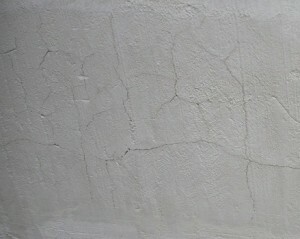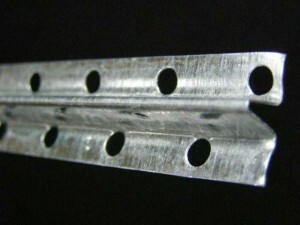At what temperature can be plastered. Terms and preparatory work. Heating and drying. Solutions with antifreeze additives
Table of contents
- 1 Terms and preparatory work
- 2 Heating and drying
-
3 Solutions with antifreeze additives
- 3.1 Chlorinated water
- 3.2 Potash
- 3.3 ammonia water
- 4 Total
Very often it happens that the construction of the building process continues during the winter. So the question, at what temperature can be plastered, it is most urgent.
But no less important is the question of how to be plastered in such circumstances, and what rules should be at the same time adhere to. All this will try to answer below.
Terms and preparatory work
 In winter, it is necessary to plaster, following a number of additional requirements. Humidity walls should not be greater than 8%. Plaster slopes doors and windows, niches and other structural elements of the building, undergoes rapid cooling should be carried out before the onset of winter. The solution while working with them should have a temperature of between + 8 ° and above.
In winter, it is necessary to plaster, following a number of additional requirements. Humidity walls should not be greater than 8%. Plaster slopes doors and windows, niches and other structural elements of the building, undergoes rapid cooling should be carried out before the onset of winter. The solution while working with them should have a temperature of between + 8 ° and above.This is possible only when the hopper, mud channel (for plastering machine method) are insulated, and the temperature in rooms kept at from +10 ° C.

The result of plastering work in not heated room
External plastering works at temperatures mode below -5 ° C allowed only solutions which contain chemical modifiers, giving them the ability to solidify in the cold and achieve the calculated strength. You can also work with solutions containing ground quicklime.
Walls made by frost, can be plastered, if the part of the wall works thawed to a depth of at least half of it. Using hot water to accelerate the warming of the walls and remove the ice with them, are strictly prohibited.
Facilities that require plastering, pre-prepared. Prokonopachivayutsya required gap between window, door frames and walls, plastered slopes, window glazing. The doors are tightly closed, floor and attic floor are insulated.
Winter plaster can be at an average temperature in the premises in the outer walls at a height of 50 cm from the level of floors of at least +8 ° C.
At the ceiling temperature should not exceed +30 ° C. At higher temperatures modes solution dries rapidly, cracks and loses strength.
Heating and drying

Heater to dry the plaster (the price - 14 000 rubles.)
Materials based on various binders dried differently. For drying and hardening lime plasters need a small amount of carbon dioxide. Drying accelerated method is contraindicated: plaster becomes fragile and heavily cracked.
Lime, lime-plaster finish dries around 10-14 days. It is necessary to ventilate the room two or three times a day. Cement, cement-lime mortar is required to dry 6-7 days.
The room is not aired because solution requires the humid air. When dry complex mixtures of plasters as a reference grab main binder.
The best cure for a normal heating plaster - central. If it is, and no furnace heating, arranged temporary.
If a large amount of work, used heaters. They plaster dried about 6-8 days at a temperature of +30 ° C. Once it has dried to a moisture content of 8%, the room temperature is set to +8 ° C, since the walls are not cooled and are not covered with wet spots.
You can also use heaters. The set includes self-heater with a furnace, the blowing unit with a centrifugal fan, which forces the hot gas through the pipes, tubes and set another fan, forcing the air.
Solutions with antifreeze additives
To the question whether it is possible to plaster in the cold, the answer is simple.
In the unheated areas, and when the outside temperatures below zero, the plaster is prepared with chemical additives.
Chlorinated water
For exterior use mixtures which shuts chlorinated water. They can operate at temperature regimes to -25 ° C.
To prepare supplements, pour water into the boiler and heat to +35 ° C. Put in a container bleach rate of 15 kg per 100 L of water. Mix the composition until the lime is completely dissolved. The resulting milk should stand for 1-1.5 hours.
Drain sediment into the storage container and use as needed. The composition should not be heated more than +35 ° C, otherwise chloro evaporate. Use chlorinated water, which does not defend, it is forbidden, in contact with the dregs in the plaster is cracked.
At a supplement, you can make and cement complex solutions and plaster, brick, concrete and wood surfaces. Other types of plaster on it can not be done.
For shlakoblochnogo, brick and wood walls need to use chlorinated mixture: cement + sand + lime in proportions of 1: 1: 6 or clay with cement + sand + slag in a ratio of 1: 1.5: 6. Concrete plastered cement-sand mortar in a ratio of 1: 3.
Attention! When working with chlorine mixtures wear a dust mask, canvas overalls, rubber gloves, apron and boots. After drying these solutions are harmless, as chlorine are gradually volatilized.
Potash
Solutions of the additive do not form efflorescence potash and do not promote corrosion of metal, recommended for plastering reticulate-reinforced structural elements.
On potash aqueous solution made cement, cement-clay and lime-cement mixture. For the manufacture of plaster is taken low cement grades. Displacement added potassium carbonate depends on the air temperature.
If this indicator is not below -5 ° C, potash requires 1% of the volume of the mixture in the dry state. When the air temperature -5 - -15 ° C 1.5% additive is necessary. If it's freezing below -15 ° C, is added 2% additives.
Cement mortars with clay-sand filler are prepared in the proportions of 1: 0.2: 4 to 1: 0.5: 6. Dried clay mixed with cement and sand, and then shuts aqueous potash solution.
Lime-cement mixture should be composed of no more than 20% lime (by weight of cement).
Cement slurries have to be low-fat, in a proportion of 1: 3. Potash salt dissolves in the water, on which the mixture is made. For work necessary to use a solution having a temperature in excess of +5 ° C.
Note! It should be used within one hour of preparation.
The solution was kept in an insulated container. You need to dress the same way as you would with a chlorinated solution.
ammonia water

In the photo ammonia water
This modifier is produced in factories, and diluted to the desired concentration at a construction site. Care should be taken that the temperature of both ammonia and ordinary water, which it is diluted, not exceed +5 ° C. At higher temperatures, ammonia will evaporate.
If the ammonia concentration in water is 25%, to obtain the finished additive having a concentration of 6%, per liter of solution factory added 3.16 liters of ordinary water. If ammonia water was acquired with a 15% concentration, then added to 1 liter of 1.5 liters of water.
Instructions on the use of their hands:
This modifier should be stored in hermetically sealed containers that are suitable for glass bottles with ground glass stopper.
Ammonia water can be added to cement and cement-lime-sand mortar, and here the lime-gypsum, cement, clay and lime mixture of this additive can not be shut.
When grouting concrete surfaces need to use cement mixture in proportions of 1: 2-1: 4. Plastering of brick, cinder block and wood surfaces - cement-lime-sand composition should have a ratio of 1: 1: 6-1: 1: 9.
Lime diluted ammonia water whose temperature regime should not be lower than +5 ° C. The heating temperature depends on the plaster the same period of outdoor air.
If the outside air is cooled to -15 ° C, the temperature of the solution during handling should be + 2-3 ° C. When the outside air mode to -25 ° C, temperature of the mixture should be maintained at no less than +5 ° C.
Working solutions can be doped with ammonia at ambient temperature to -30 ° C, and is best performed on beacons plastering
Finish on ammoniacal modifier after freezing has high strength, its surface film does not peel off. Such plasters continue to gain strength values both in the cold and at temperatures above zero after thawing.
Total
We hope our stuff was useful for you. We can only offer you the video in this article and I wish you good luck in the difficult construction business.


